Creating perfectly sized social media content is essential for engagement and professional presentation. Each platform has unique post image, video, and text limits requirements. This comprehensive guide will help ContentStudio users optimize their content dimensions for maximum impact across all major social networks.
The easiest way to manage and grow your social channels.
Try ContentStudio for FREE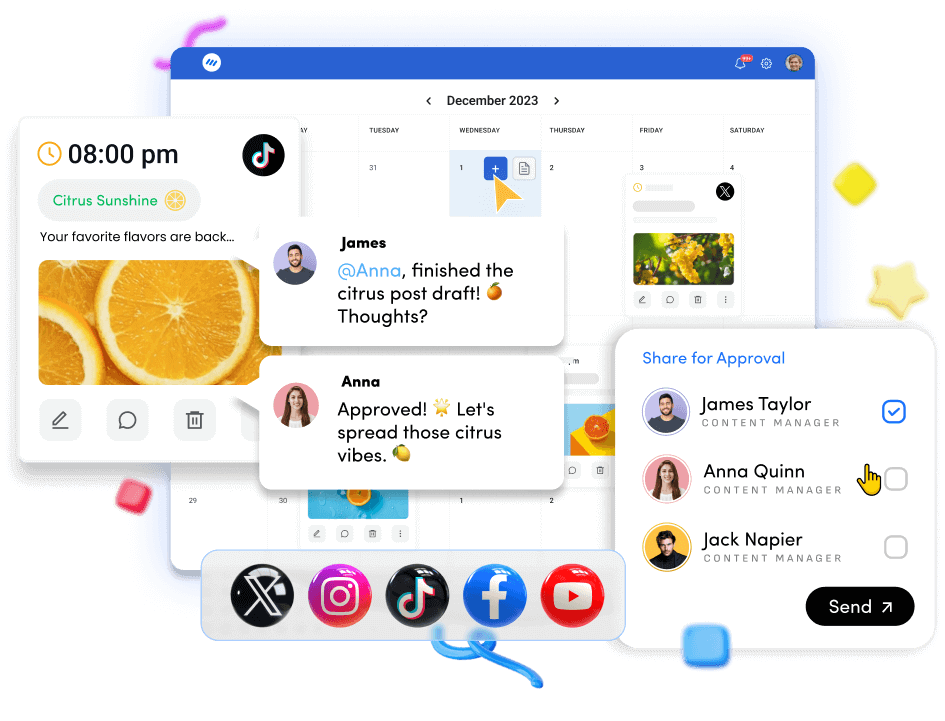
A quick social media post sizes cheat sheet.
Here’s a quick look at the image dimensions for different social media platforms:
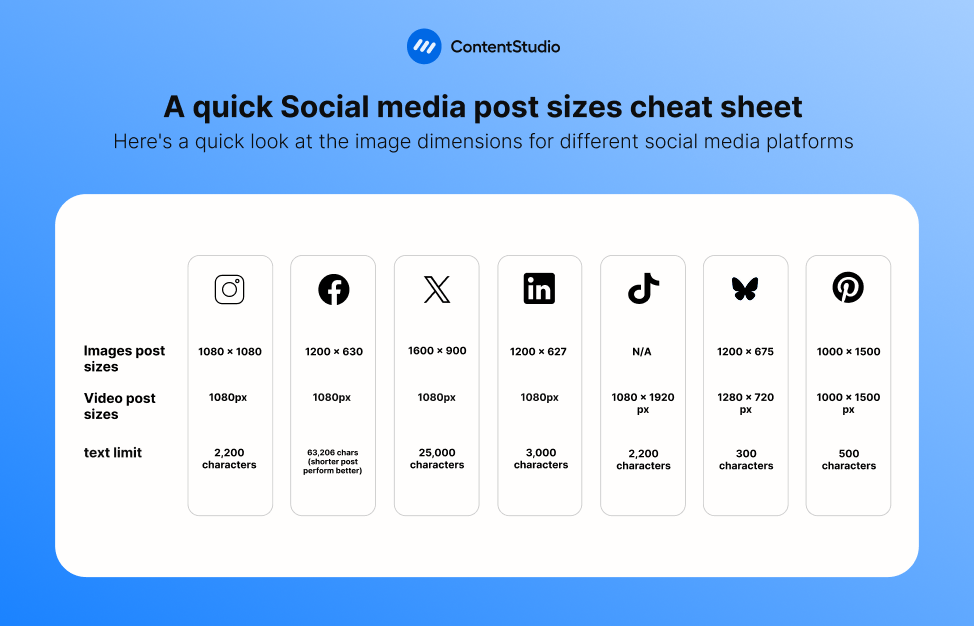
How about we take a closer look at each one together? Sound good?
Facebook post sizes

Facebook remains one of the most versatile and widely used social platforms, with over 3 billion monthly active users, supporting various post content formats.
Images post sizes
- Landscape post: 1200 x 630 pixels (recommended)
- Square Post: 1080 x 1080 pixels
- Portrait post: 1080×1350 pixels
Video post sizes
- Feed Video Aspect Ratio: 16:9 (landscape) or 9:16 (portrait)
- Feed Video Resolution: 1280 x 720 pixels minimum
- Video Length: 1 second to 240 minutes
- Reels: 1080 x 1920 pixels, up to 90 seconds
Text limits
- Post Text: 63,206 characters (though shorter posts typically perform better)
- Headline: 40 characters
- Link Description: 27 characters
Facebook’s algorithm typically rewards native content that keeps users on the platform, so uploading videos and images directly rather than sharing links often results in better reach and engagement.
Instagram post sizes

Instagram is the visual powerhouse in social media, focusing on aesthetics and visual storytelling with over 2 billion monthly active users.
Feed post sizes
- Square Image: 1080 x 1080 pixels (minimum 600 x 600 pixels)
- Landscape Image: 1080 x 566 pixels
- Portrait Image: 1080 x 1350 pixels
- Carousel Posts: 1080 x 1080 pixels (up to 10 images/videos)
Video post sizes
- Feed Video: 1080 pixels minimum width
- Square (1:1): 1080 x 1080 pixels
- Portrait (4:5): 1080 x 1350 pixels
- Landscape (16:9): 1080 x 566 pixels
- Length: Up to 60 seconds in feed, 90 seconds for Reels
Text limits
- Caption: 2,200 characters
- Hashtags: Up to 30 hashtags per post
Instagram favors high-quality visual content with strategic use of hashtags. The platform prioritizes storytelling through visuals, with captions serving as supporting content rather than the main focus.
LinkedIn post sizes
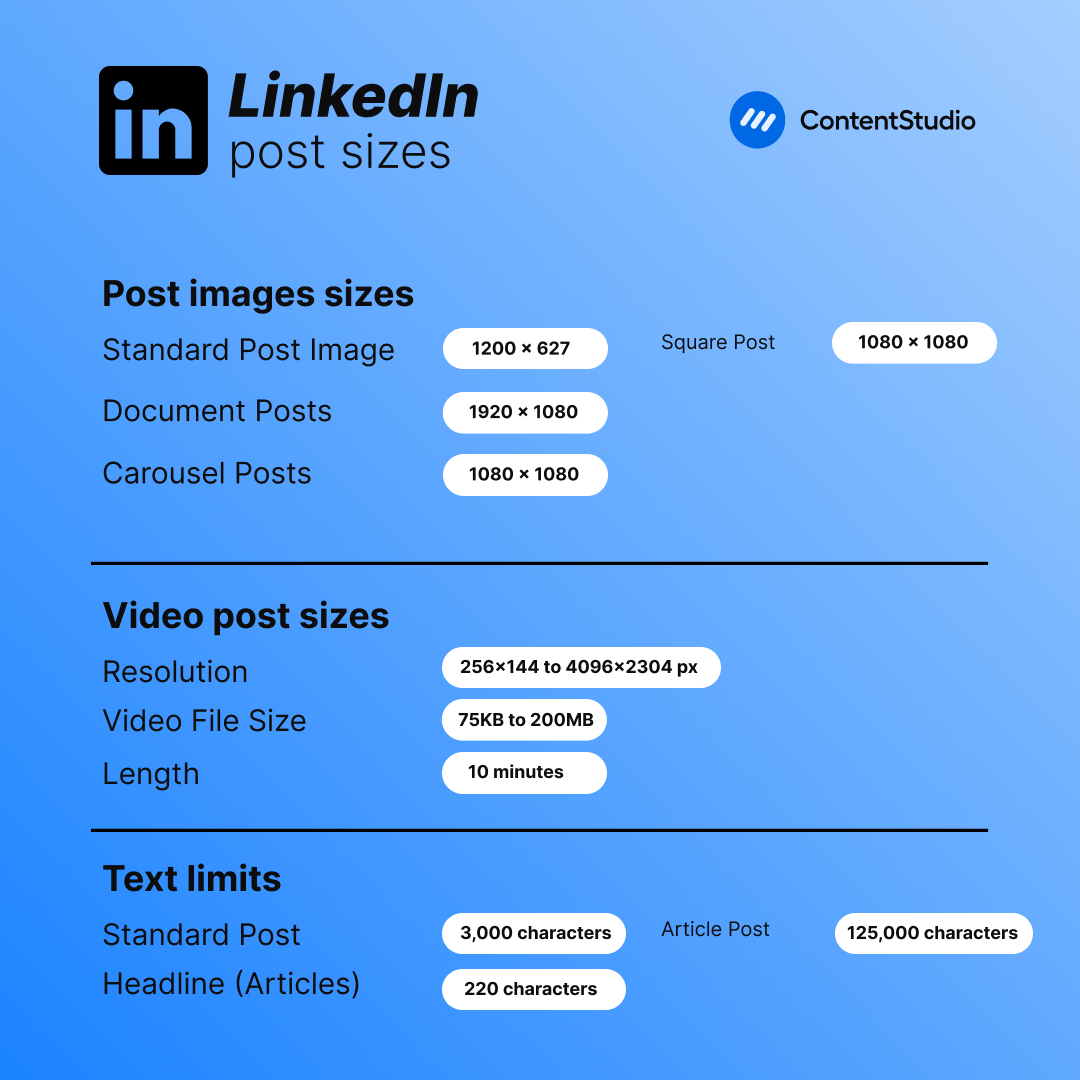
LinkedIn is the premier professional networking platform with approximately 1.15 billion users globally. Content here should be polished and business-appropriate.
Feed post sizes
- Standard Post Image: 1200 x 627 pixels (recommended)
- Square Post: 1080 x 1080 pixels
- Carousel Posts: 1080 x 1080 pixels
- Document Posts: 1920 x 1080 pixels per slide
Video posts sizes
- Resolution: 256 x 144 pixels (minimum) to 4096 x 2304 pixels (maximum)
- Video File Size: 75KB to 200MB
- Length: 10 minutes
Text limits
- Standard Post: 3,000 characters
- Article Post: 125,000 characters
- Headline (Articles): 220 characters
LinkedIn’s algorithm favors professionally relevant content, thought leadership, and industry insights. The platform rewards engagement, especially from within your professional network.
X (formerly Twitter) post sizes
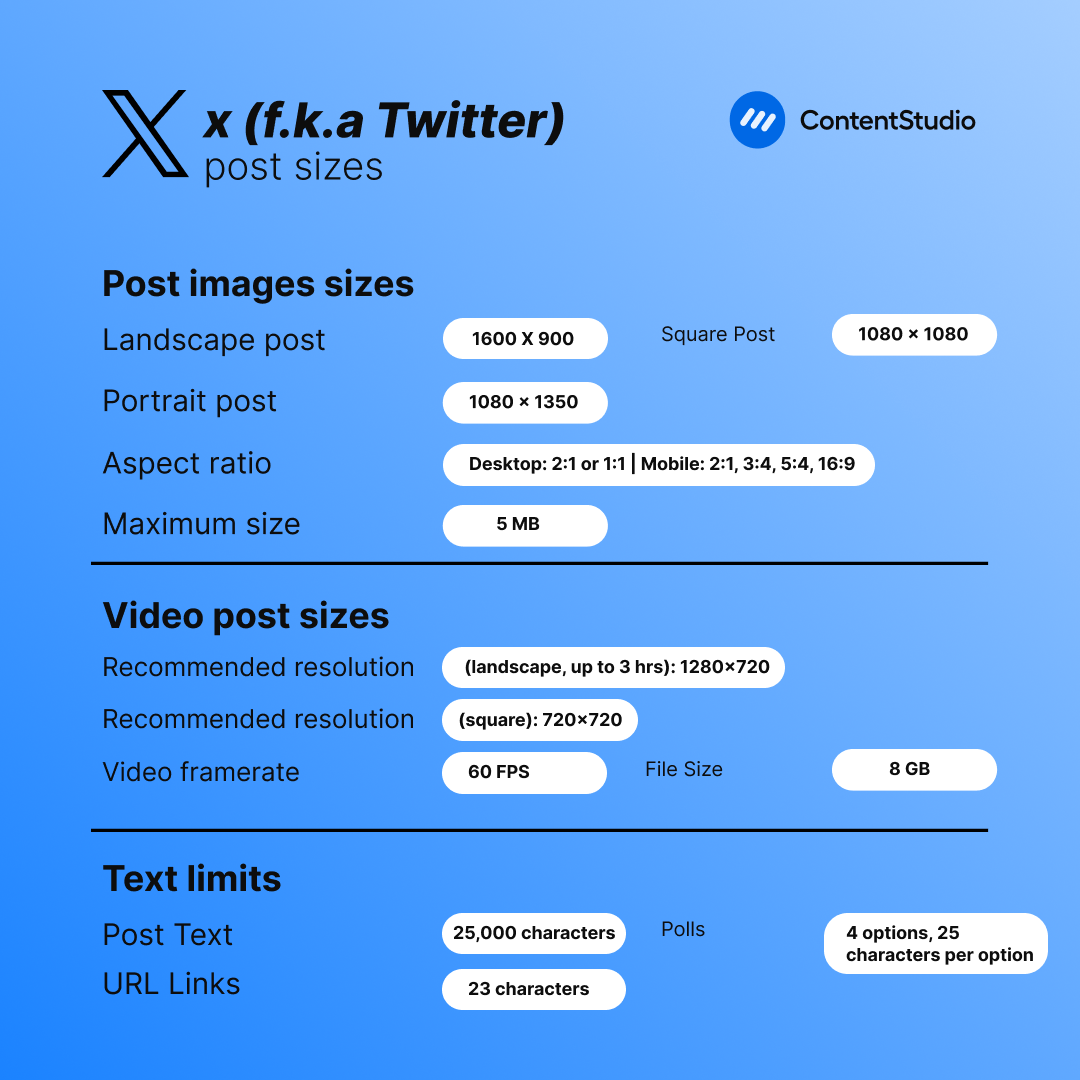
X continues to be a key platform for real-time updates and conversations with approximately 650 million monthly active users. Its format remains focused on concise messaging despite expanded character limits.
Feed post sizes
- Landscape post: 1600 by 900 pixels (recommended)
- Square post: 1080 by 1080 pixels
- Portrait post: 1080 x 1350 pixels
- Aspect ratio: Use 2:1 or 1:1 on desktop and 2:1, 3:4, 5:4 or 16:9 on mobile
- Maximum size: 5 MB
Video post sizes
- Recommended resolution (landscape, up to 3 hrs): 1280×720
- Recommended resolution (square): 720×720
- Video framerate: 60 FPS
- Maximum Length: 140 seconds for standard posts
- File Size: 8 GB
Text limits
- Post Text: 25,000 characters
- Polls: 4 options, 25 characters per option
- URL Links: Counted as 23 characters regardless of actual length
X works best with concise, attention-grabbing content. Despite the expanded character count, shorter posts with compelling visuals tend to perform better. The platform emphasizes real-time conversation and trending topics.
Snapchat post sizes

Snapchat remains popular with younger audiences, with approximately 850 million monthly active users. The platform is known for its ephemeral, vertical content format.
Snap post sizes
- Post Image Size: 1080 x 1920 pixels (9:16 ratio)
- Full-screen Vertical: Essential for all content
- Maximum file size: 5MB
Video post sizes
- Resolution: 1080 x 1920 pixels
- Aspect Ratio: 9:16 (vertical orientation only)
- Length: 3 to 180 seconds (if file size does not exceed 1 GB)
- File Size: 1 GB or less
Text limits
- Caption: 25 characters
- Headline: Up to 34 characters with spaces
Snapchat’s format is designed for immersive, full-screen vertical content. The platform emphasizes authentic, in-the-moment content rather than highly polished productions.
TikTok post sizes
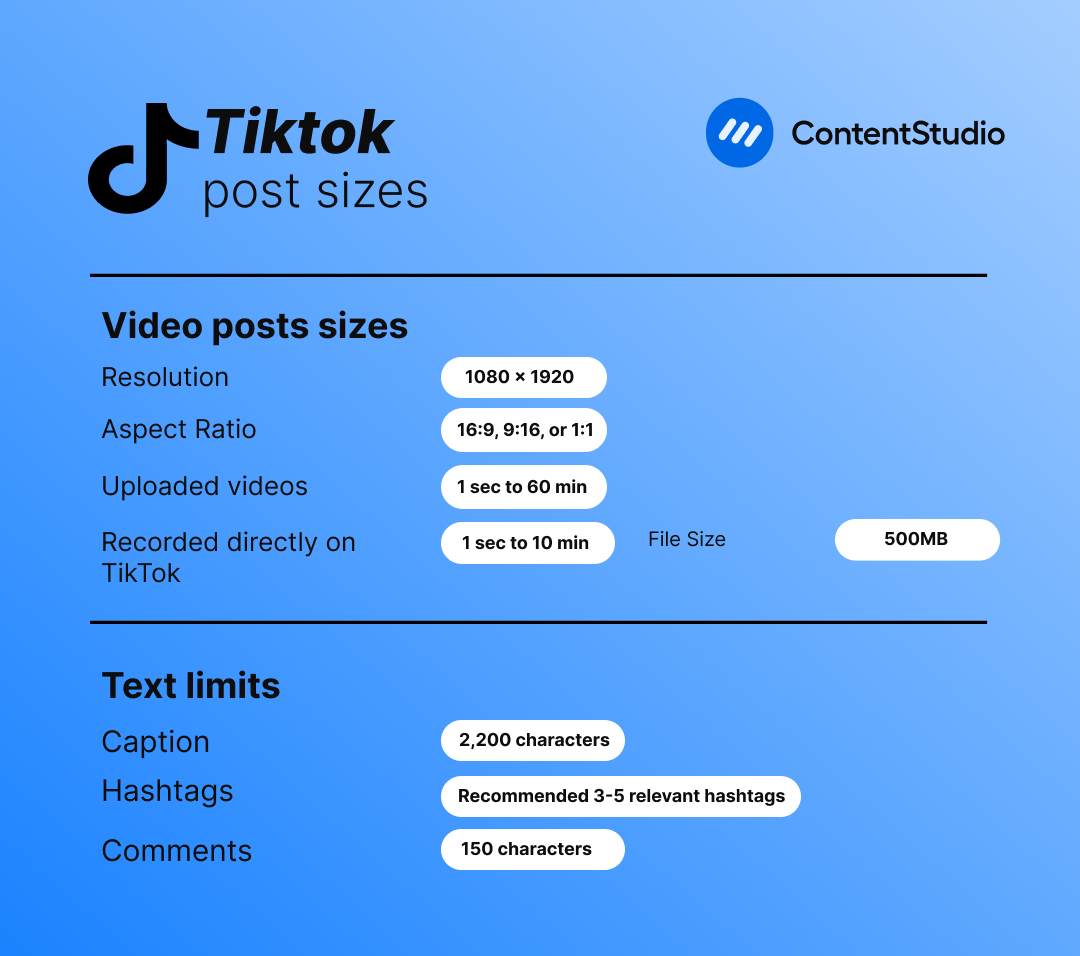
TikTok has rapidly grown to over 1.12 billion monthly active users worldwide. The platform specializes in short-form video content with a strong emphasis on trends and music.
Video post sizes
- Resolution: 1080 x 1920 pixels (recommended)
- Aspect Ratio: 16:9, 9:16, or 1:1
- Recorded directly on TikTok: 1 second (min) to 10 minutes (max).
- Uploaded videos: 1 second (min) to 60 minutes (max).
- File Size: 500MB maximum
Text limits
- Caption: 2,200 characters
- Hashtags: Recommended 3-5 relevant hashtags
- Comments: 150 characters
TikTok’s algorithm prioritizes content completion rates and engagement. The platform rewards creative, trending content that captures attention quickly and maintains viewer interest throughout.
BlueSky post sizes
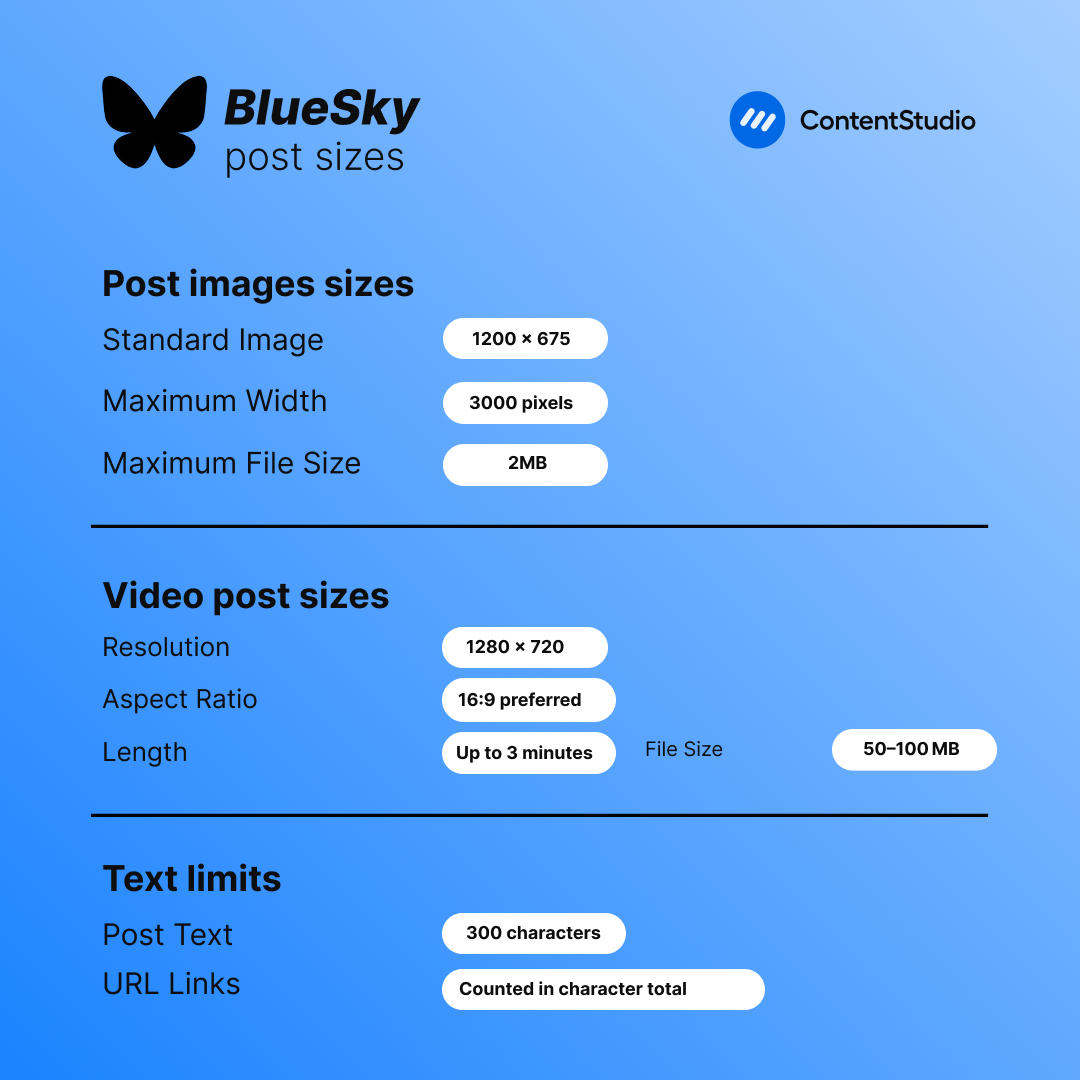
BlueSky is a newer decentralized social platform gaining popularity as an alternative to X, with a growing user base of early adopters and tech enthusiasts. It would hit 53 million users by December 2025. And by December 2026, Bluesky will have surpassed 84 million users.
Feed post sizes
- Standard Image: 1200 x 675 pixels (16:9 ratio recommended)
- Maximum Width: 3000 pixels
- Maximum File Size: 2MB
Video post sizes
- Resolution: 1280 x 720 pixels (recommended)
- Aspect Ratio: 16:9 preferred
- Length: Up to 3 minutes
- File Size: larger than 50MB and less than 100MB
Text limits
- Post Text: 300 characters
- URL Links: Counted in character total
BlueSky combines elements of Twitter/X with decentralized protocols. The platform emphasizes chronological timelines and user control, with content that values quality discussion and community engagement rather than viral metrics.
Pinterest post sizes
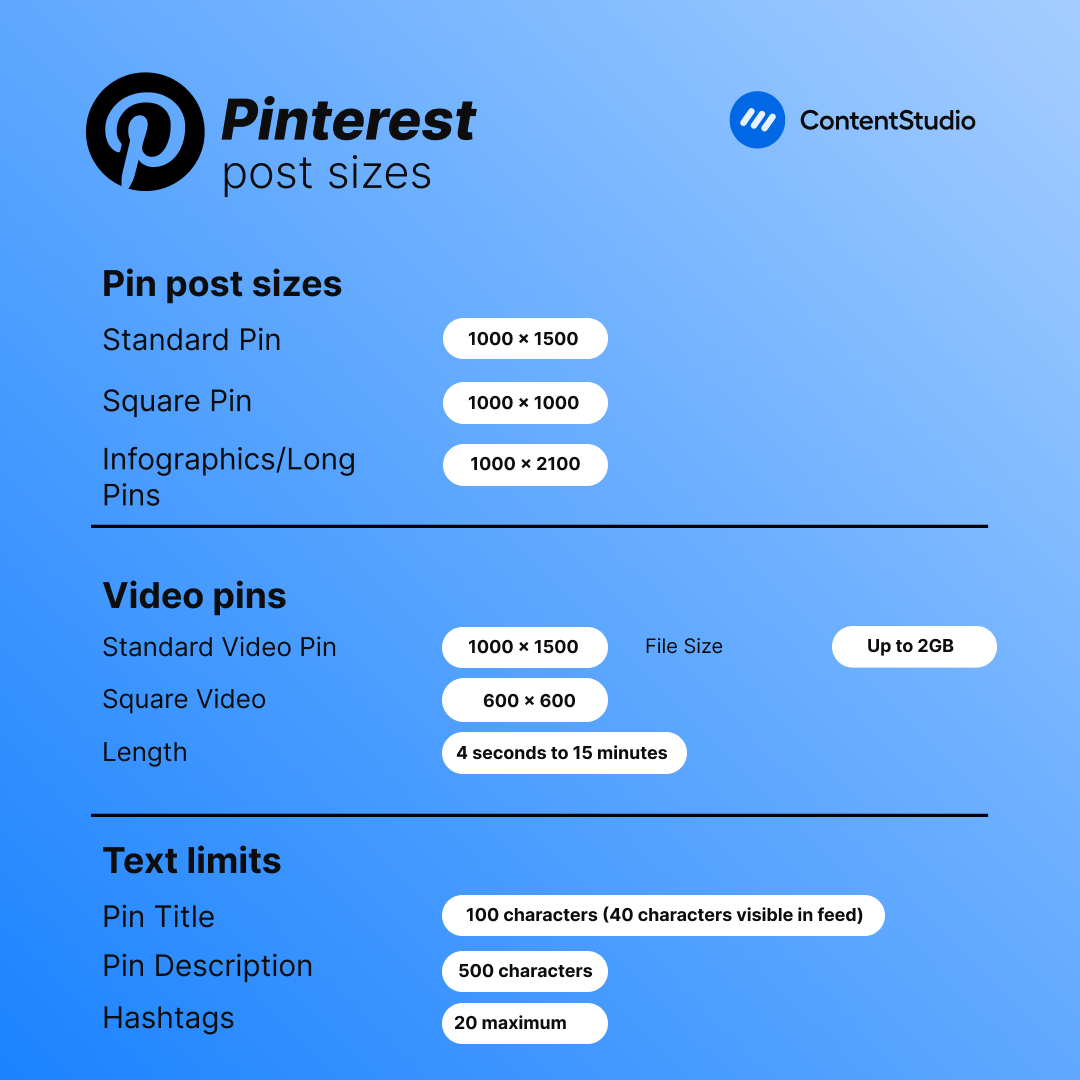
Pinterest serves as a visual discovery and inspiration platform with over 453 million monthly active users worldwide. The platform functions as a visual search engine where content can remain discoverable for months or even years.
Pin post sizes
- Standard Pin: 1000 x 1500 pixels (2:3 ratio recommended)
- Square Pin: 1000 x 1000 pixels
- Infographics/Long Pins: 1000 x 2100 pixels (maximum)
Video pins sizes
- Standard Video Pin: 1000 x 1500 pixels (2:3 ratio)
- Square Video: 600 x 600 pixels
- Length: 4 seconds to 15 minutes
- File Size: Up to 2GB
- Ideal Length: 15-30 seconds for best performance
Text limits
- Pin Title: 100 characters (40 characters visible in feed)
- Pin Description: 500 characters
- Hashtags: 20 maximum (though fewer, more targeted tags perform better)
Pinterest functions differently from other social networks as it’s primarily a discovery platform. Content should be evergreen, visually appealing, and optimized with relevant keywords in descriptions. The platform heavily favors vertical content that fills more screen space on mobile devices.
Beyond dimensions: Best practices for powerful Social Media Posts in 2025
While perfect dimensions form the foundation of great social media content, how you use that digital real estate determines true engagement. Let’s explore how to maximize the impact of your perfectly-sized posts across all platforms:
1. Know your audience’s visual preferences
Understanding your audience goes beyond demographics to visual preferences. Different audience segments respond to different visual styles within the size constraints we’ve outlined:
B2B audiences often engage more with LinkedIn posts that use the full 1200 x 627 pixels for data visualizations rather than stock photography. Meanwhile, B2C campaigns typically perform better on Instagram when using the 1080 x 1350 portrait format with lifestyle imagery.
Analyze which dimensions and visual styles generate the most engagement for your specific audience segments across platforms. A tech audience might prefer infographics in square formats, while fashion followers may engage more with full-height vertical content.
2. Create size-optimized visual content
The dimensions you choose directly impact how your message is received. For maximum engagement:
- Match visual complexity to available space—complex infographics need larger formats like Pinterest’s 1000 x 1500 pixel pins
- Ensure all text remains readable even at the smallest display size on each platform
- Use high-resolution images (2x the required dimensions) to ensure crisp display on high-DPI devices
- Create templates for each platform’s unique dimensions to maintain visual consistency
The most successful brands in 2025 create platform-specific content rather than simply cropping the same image differently.
3. Craft size-appropriate captions
Each platform’s character limits and display formats should influence your caption strategy:
- X’s 25,000 character limit might be generous, but engagement drops significantly after 100 characters
- Instagram’s 2,200 character captions perform best with key messages in the first 125 characters before the “more” cutoff
- LinkedIn’s 3,000 character posts see highest engagement when kept between 1,000-1,500 characters
- Facebook’s massive 63,206 character limit doesn’t mean you should use it—posts under 80 characters receive 66% more engagement
Remember that on mobile devices (where over 80% of social media is consumed), longer captions require more scrolling and often go unread.
4. Implement platform-specific hashtag strategies
Hashtags function differently across platforms, affecting both visibility and engagement:
- Instagram: 3-5 highly relevant hashtags outperform posts using the 30-hashtag maximum
- LinkedIn: 2-3 professional, industry-specific hashtags perform best
- X: 1-2 trending hashtags increase visibility in relevant conversations
- TikTok: 3-5 trend-based hashtags help with algorithm discovery
- Facebook: Hashtags generally show minimal engagement impact; use sparingly
The hashtag strategy that works for your perfectly-sized Instagram post will likely reduce engagement on your LinkedIn content. Platform-specific hashtag approaches are as important as platform-specific dimensions.
5. Design clear, size-optimized CTAs
Call-to-action effectiveness varies by platform size constraints:
- For Instagram’s 1080 x 1080 square posts, center CTAs for maximum visibility
- On Facebook’s 1200 x 630 rectangular posts, place CTAs in the bottom right corner where eyes naturally land
- For TikTok’s 1080 x 1920 vertical videos, place CTAs in the middle third of the screen to avoid interface elements
- With X’s 1600 x 900 landscape posts, position CTAs on the right side of images for highest click-through rates
Test different CTA placements within each platform’s dimensions to find what works best for your specific audience.
6. Maintain posting consistency across dimensions
Content consistency matters across both time and formats:
- Create content calendars that plan for platform-specific dimensions
- Maintain visual consistency while respecting each platform’s unique size requirements
- Schedule consistently to build audience expectations
- Consider how different post formats (Stories, Reels, standard posts) interact within the same platform
Social Media Content Calendar Stay consistent and organized with Contentstudio’s social media content calendar for marketers and agencies.
7. Actively engage within platform contexts
How you engage with audience responses should adapt to each platform’s interface:
- Instagram’s comment threading works best for ongoing conversations
- LinkedIn’s professional context requires more thoughtful, value-added responses
- X’s character limits necessitate concise, quick-witted engagement
- TikTok’s comment section rewards personality and trend awareness
Remember that your engagement strategy must account for how comments and responses appear on each platform’s unique interface and display parameters.
8. Analyze size-specific performance metrics
Different dimensions require different success metrics:
- For 9:16 vertical video content (TikTok, Instagram Reels), completion rate is the key indicator
- For 1:1 square posts (Instagram feed), engagement rate becomes more important
- For text-heavy formats (LinkedIn), comment quality often matters more than quantity
- For 1200 x 627 link posts (Facebook), click-through rate is the critical metric
9. Maintain authentic voice across formats
Brand authenticity must remain consistent despite varying format constraints:
- Ensure your brand personality comes through regardless of character limits
- Adapt tone appropriately to each platform while maintaining core brand identity
- Use platform-native features authentically rather than forcing content to fit
- Share behind-the-scenes content appropriately sized for each platform
The most successful brands maintain authentic voices while respecting platform constraints,
They don’t try to force TikTok-style content into LinkedIn’s professional format or vice versa.
10. Adapt strategically to platform evolutions
Social media dimensions and specifications continue to evolve:
- Stay current with platform updates and dimension changes
- Quickly adapt templates when platforms modify their preferred dimensions
- Test new format options early (like when Instagram introduced 1080 x 1350 portrait posts)
- Maintain flexible design systems that can adapt to changing specifications
By combining these best practices with the exact dimensions provided throughout this guide, ContentStudio users can create social media content that not only fits perfectly on each platform but also drives meaningful engagement with their audience.
Remember: The right dimensions get you in the door, but these best practices help you own the room.
Simplified social media marketing for individuals & agencies.
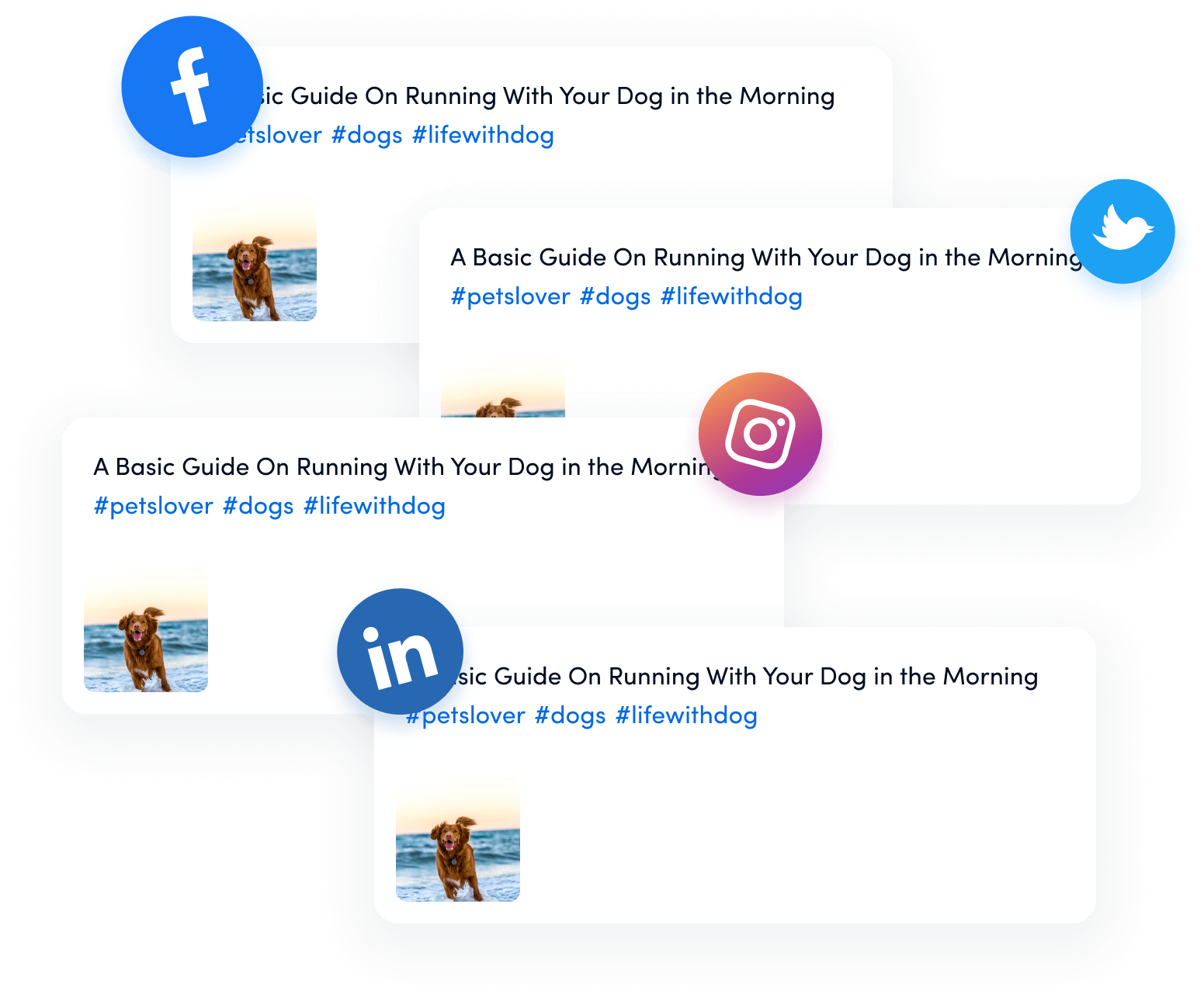
Conclusion
As we’ve explored throughout this guide, social media post sizes are far more than technical specifications—they’re the canvas upon which your brand’s digital story unfolds. In the highly competitive social landscape of 2025, attention to these dimensional details can mean the difference between content that captures attention and content that gets scrolled past.
Social media success in 2025 belongs to those who master both the science of proper dimensions and the art of compelling content. By combining technical precision with creative excellence, ContentStudio users can ensure their social media presence stands out in increasingly crowded digital spaces.
Remember: The properly sized post opens the door, but your content’s quality determines whether your audience stays engaged.
Happy posting!
FAQ’s
1. Which aspect ratio works best across most platforms in 2025?
The 4:5 ratio (1080 x 1350 pixels) has emerged as the most versatile format in 2025. It displays well on Instagram, Facebook, and LinkedIn feeds and is easily adaptable to vertical formats like Stories and Reels with minimal cropping. This ratio provides enough vertical space for mobile video content viewing while still working on landscape-oriented platforms.
2. How do I optimize images for the unified Meta platforms in 2025?
With Facebook and Instagram further integrating their visual systems in 2025, content automatically appears across both platforms. The optimal approach is to use 1080 x 1350 pixel images (4:5 ratio), which display correctly in both Instagram’s full-width format and Facebook’s variable-width feed. For Stories/Reel content that crosses both platforms, the 1080 x 1920 pixel (9:16) format remains standard.
3. What are the correct video dimensions for maximum reach across TikTok, Reels, and YouTube Shorts?
The vertical 9:16 ratio (1080 x 1920 pixels) remains the universal standard for short-form video in 2025. However, TikTok now favors slightly taller content (9:16.5). Simultaneously, YouTube Shorts performs best with standard 9:16.
4. How have LinkedIn’s post dimensions changed with their 2025 interface update?
LinkedIn’s standard posts now display best at 1200 x 627 pixels (shifting from the previous 1104 x 736), while their new “Professional Stories” format requires 1080 x 1920 pixels. Document posts remain 1920 x 1080 pixels per slide but now support animated transitions between slides when properly formatted.
5. What dimensions should I use for X’s new premium media formats?
X (formerly Twitter) introduced enhanced media specifications for their premium subscribers in 2025. Standard posts remain at 1600 x 900 pixels, but premium users can now post “Enhanced Media” at 2048 x 1152 pixels with significantly less compression. The platform also introduced carousel posts at 1200 x 675 pixels per image with up to 10 images per carousel.
6. Are square images still relevant for social media in 2025?
Square images (1080 x 1080 pixels) will remain relevant in 2025 but have become less dominant as platforms optimize for vertical scrolling. They’re ideal for profile pictures, Instagram grids, and LinkedIn company page posts. However, vertical formats (4:5 or 9:16) now receive up to 40% more engagement on most platforms as they occupy more screen real estate on mobile devices.

Leave a Reply